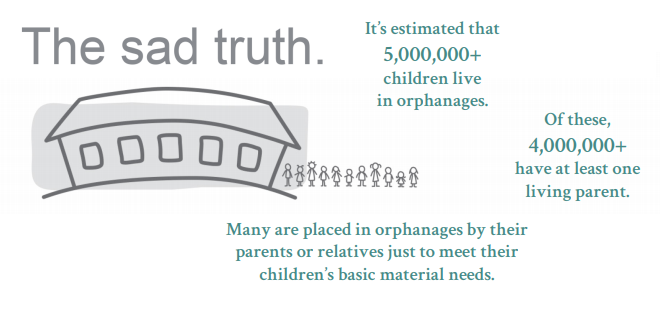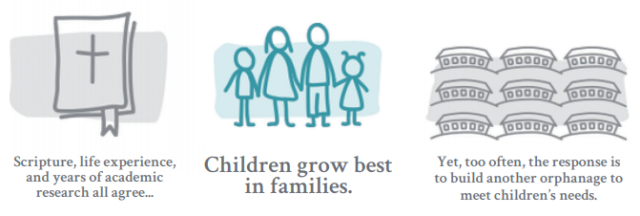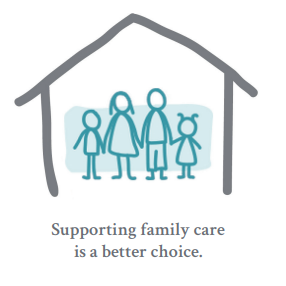
Are We Serving Orphans? How churches are transitioning to best-practice care services
At Mission Central we like to share observations from mission workers on what they’ve learned during their time serving others.
"Our church sends youth to love on kids at an orphanage each summer. The orphans get excited about all that our teens do for them. Let me show you some pictures!"
Does this statement describe your church’s connection to an orphanage somewhere around the world? Often orphanage ministry is one of a church’s most-popular global missions efforts because there is such an emotional attachment to needy children. Yet disturbing facts about the orphanage model, especially the impact of Western short-term ministries in Majority World orphanages, are causing many churches to rethink their strategy for orphan ministry abroad.
The orphanage model was abandoned decades ago in almost every Western society, yet orphanages have continued to house vulnerable children in other parts in the world. However, in the past few years a number of orphanage ministries around the globe, as well as some supporting churches in the West, have changed course as they recognized the following realities.
- Most so-called orphans still have at least one living parent or other family members who are willing to care for them.
- Poverty is a primary reason that children are placed in orphanages.
- Strengthening families and addressing children’s basic needs could enable many to remain in family care.
- Families provide the best environment for a child’s development.
- Children living in orphanages are at greater risk for long-term negative impacts on their social, emotional, and cognitive development.
- Good practice dictates having a full range of care options available for children in need, with emphasis on care within families.
- All vulnerable children need to be protected from abuse, neglect, and deprivation of basic needs, whether they live in an orphanage or a traditional home.
- Ensuring that all children are well cared for, ideally within a family, requires the involvement and collaboration of multiple entities.
If your church is deeply involved with an orphanage ministry, those facts may be unsettling. Making a major strategy transition is not easy, but Western church leaders can’t ignore their responsibility to engage best practices.

One Church's Experience
Liberty Christian Fellowship had partnered with an orphanage in Haiti for nine years. An enthusiastic team of church members organized ministry trips and were passionate about supporting the orphanage. Yet others who went to serve there came back disillusioned about the ministry; an honest report from one team made it clear that drastic change was needed. Missions Pastor Joe Stewart recounts the following.
Studying the Big Picture
Soon after I came on as missions pastor two years ago, I spent a week observing this ministry first hand. Among other things, I learned that a fair number of the children were not orphans but came from families who said they had no resources to care for them. Others were street children placed in the orphanage by the government.
I came home aware that something had to change, yet I knew that I needed to build some consensus. Kids are a trump card. When you are dealing with orphans, people’s hearts are very tied to them, and they find it hard to be objective.

To move forward with consensus, we decided to involve the church’s overall leadership team, the missions leadership team, and the leaders of our Haiti missions team—16 people in all—in the review process. Creating this inclusive task force would increase the transparency of our process. Discussions included orphan care in general and specifically our partner orphanage. There were a lot of opinions.
We soon recognized that we needed objective input, so I initiated discussions with six organizations that were specialists in orphan care. Some promoted only family reunification. Some also did orphanage ministry. Some were Christian organizations; some were not. I quickly learned a lot. In addition, we collected research about the psychological issues related to children in orphanage care. All of this input was carefully collated and disseminated to the entire group of 16.
Identifying Realistic, Healthy Alternatives
Based on what we learned, Lead Pastor Tim Fritson and I developed a long list of improvements that would be needed to make the orphanage meet government standards and provide minimum quality care for the children and staff. The list was daunting.
Two things became obvious: (1) We couldn’t fund or implement from the U.S. all of the changes that were vital to meet the standards we had become convinced were essential, and (2) we needed to have a face-to-face discussion with the Haitian leader of the ministries. We were ready to help fund a family reintegration program that would cost far less and be better for the children in the long run.
Tim and I flew to New York City (where the Haitian leader now resides) and sat down with this brother, a godly man whom we believe desires to see the ministries under his leadership flourish. He seemed genuinely interested in our research.
However, he was unwilling to consider another model. We sadly realized that we could not continue our partnership, but we did commit to continue support through the end of the current year so as to not create an immediate crisis for the organization.
Helping the Congregation Transition

Back at our church, we had some difficult meetings with our task force. We talked. We had prayer meetings asking God for unity. But it became clear that several people were not willing to dissolve our partnership, no matter what.
In the end, our church leadership team made the final decision to withdraw from the partnership. We met with the task force and with the entire Haiti ministry team to inform them of the decision and answer questions. Subsequently an email informed the congregation that the partnership had been dissolved, and a follow-up meeting was scheduled to provide additional information to any who were interested.
We are using this transition to continue to realign all of our missions endeavors with our priority to focus on indigenous church planting in unreached people groups. We are also committed to being advocates for family reunification. In the future, some of our Global Impact Teams may engage in a project related to vulnerable children and their families. It’s been an arduous and at times painful seven months of working our way through this issue, but I believe we are leading in the right direction.
Since 2017, Joe Stewart has been Missions Pastor at Liberty Christian Fellowship, where he and his family have attended since 2012.
Supporting churches have great potential to impact ministries to transition toward better practices. It is challenging to ask tough questions of a partner you are trying to empower. However, we have found that global partners are often excited when a church supports them in trying new things to improve their care for children.
Liberty’s story highlights the challenges of walking a church through the process of moving away from a dearly loved ministry when it is clear that the model fails the very children it is designed to rescue. Other pastors and church missions leaders have admitted that they need to wrestle with this issue but know that it will be difficult. Perhaps you are one of them. Fortunately, helpful resources are available. Faith to Action Initiative is a coalition of ministries which has come together to provide guidance and resources on best practices to both global orphan ministries as well as local churches that want to serve vulnerable children. Their website provides an array of materials for those who want to implement healthy family reunification.
If you are a church leader just beginning to research this area, the amount of information may be daunting. Here are some suggested steps.
Getting Started
- Begin with leader learning. Familiarize yourself with the issues surrounding best practices for orphans and vulnerable children by going through the “Learn” section of the Faith to Action website. Walk your missions leadership team through the infographic and then suggest they read through the Children, Orphanages & Families booklet. If you want to delve deeper, there are lots of articles and research data on this site.
- Study together. Bring together a small group of interested persons to prayerfully and carefully work through the Journeys of Faith study together. We suggest that you include one or more people with a social work degree and experience working with vulnerable children in your own context. As you study together, ask God to give you a conviction as to the best practices for helping orphans, regardless of where they are.
- Dialog with your global partners involved in orphan care. Discuss what you are learning with your global partners heading up orphanage ministry or otherwise involved in caring for vulnerable children. Share with them pertinent information and ask them to share with you their philosophy. Many Majority World leaders are not familiar with models other than the institutional orphanage.
- Visit a new model. Plan a survey trip to visit a family reunification ministry that has a history of success.
- Consider best practices for short-term ministry to orphans. The Short-Term Missions booklet provides extensive background information and suggestions. If your church’s short-term ministry to orphans has engaged in service that may be causing harm, sit down with your short-term teams leader or others who have been involved, and talk about the potential dangers and alternatives. Be prepared for initial resistance, but give them an opportunity to consider the advantages of a different approach. Listen to their hearts as well as their words!
- Take other church leaders on the learning journey. If you church needs to make a major shift in orphan ministry, it would be wise to educate your whole pastoral staff and other church leaders in the basic issues and why you think a transition is essential. Discuss with them how you can walk your congregation through this transition.
- Invite orphan sponsors in your church into the learning process. If you are shifting away from orphanage support and have church families who have been supporting an orphan in that context, you will need to help them understand the shift. Develop concrete ways that they can continue to be engaged with children in healthy reintegration ministry. Begin educating your congregation about how implementing best practices can serve many more children than an orphanage model.
- If your church wants to begin ministry to vulnerable children, select your global partner carefully. “Finding a Child-Safe Partner: A Check List for Churches” provides guidelines.

Reprinted with permission from Catalyst Services.
https://bettercarenetwork.org/sites/default/files/Serving-Orphans-Postings-September-2018.pdf










